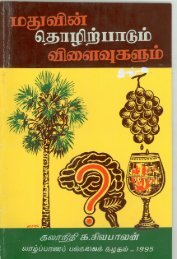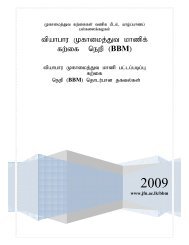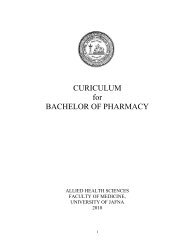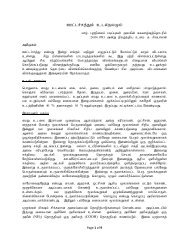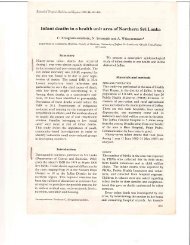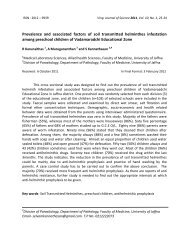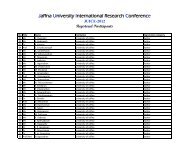MANUAL PHYSIOLOGY PRACTICAL - Repository:The Medical ...
MANUAL PHYSIOLOGY PRACTICAL - Repository:The Medical ...
MANUAL PHYSIOLOGY PRACTICAL - Repository:The Medical ...
You also want an ePaper? Increase the reach of your titles
YUMPU automatically turns print PDFs into web optimized ePapers that Google loves.
FM/UOJ<br />
Experiment M 1<br />
MEASUREMENT OF METABOLIC RATE<br />
Every living organism depends on energy change from one from to anothermetabolism<br />
- for its survival. Generally, chemical energy stored in the nutrients is<br />
converted into usable energy through ATP and finally the energy leaves the body as heat<br />
or external work performed. <strong>The</strong> rate at which energy is utilized, the metabolic rate, gives<br />
valuable information regarding the state of the body and the amount of food needed.<br />
<strong>The</strong> metabolic rate can be measured either by measuring the heat output (direct<br />
calorimetry) or by measuring the oxygen consumption which is responsible for energy<br />
release (indirect calorimetry). Direct calorimetry requires enormous facilities to contain<br />
the individual in an insulated room over long periods and it is not possible in this<br />
laboratory. Two methods are available to measure metabolic rate by indirect calorimetry:<br />
spirometer method and Weir’s method.<br />
1. Spirometer Method<br />
This is based on a subject breathing pure oxygen from a closed chamber and<br />
directing the expired air with remaining oxygen through soda lime to absorb the carbon<br />
dioxide and back to the chamber.<br />
Instruments<br />
Spirometer, oxygen analyzer, normogram for energy value of oxygen.<br />
Method<br />
Empty the breathing chamber of the spirometer and turn the exit to “atmosphere”<br />
position. Fill the chamber with oxygen. Connect one tube leading from the exit the inlet<br />
of the one way valve; the out let of the valve to the lower opening of the soda lime<br />
canister; and the out let from the canister to the breathing chamber. Seat the subject<br />
comfortably and apply mouth piece and nose clip. Wait for a few minutes to till the<br />
subject familiarizes with the set up. Switch on the kymograph at low speed, turn the exit<br />
to “spirometer” position and wait for five minutes. At the end of the time stop the<br />
kymograph, disconnect the subject and remove the tracing.<br />
Record the temperature in the breathing chamber, the atmospheric pressure at the<br />
barometer and the saturated vapour pressure at the temperature of the chamber. Obtain the<br />
energy value of the oxygen from the normogram.<br />
Note that the normogram relates the energy value to the respiratory quotient which<br />
is the ratio of carbon dioxide produced to the oxygen consumed. As the carbon dioxide<br />
has been absorbed in the soda lime, actual respiratory quotient cannot be measured. <strong>The</strong><br />
respiratory quotient, therefore, has to be deducted from the type of metabolic fuel, which<br />
depends mainly on the last meal. Assuming that the subject had a balanced meal, the<br />
respiratory quotient is assumed to be 0.85.<br />
Metabolism & Temperature<br />
Page | 121



